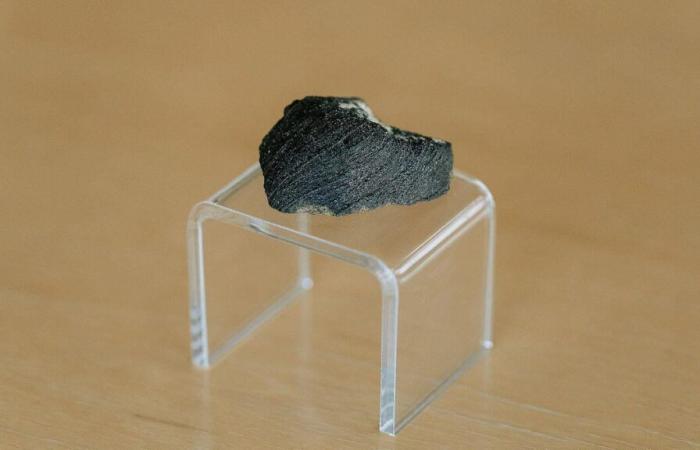It’s a tale as old as time: Scientist finds a random rock in a drawer; a century later, it helps humanity figure out when liquid water was on Mars.
Sarcasm aside, the strange history of the Lafayette meteorite, a space rock at Purdue University, may be as fascinating as the new research it has helped produce. Within the meteorite are minerals known to have formed through interactions with water. Geologists have now dated those minerals to just 742 million years ago — much more recently than many estimates of when oceans and rivers flowed on the Red Planet.
“We have demonstrated a robust way to date alteration minerals in meteorites that can be applied to other meteorites and planetary bodies to understand when liquid water might have been present,” said Marissa Tremblay, an assistant professor at Purdue, in a statement.
Past life on Mars? Here’s what new NASA evidence points to.
An artist interprets what Gale crater on Mars might have looked like during one of its ancient, wet periods.
Credit: NASA illustration
Despite the team’s success in dating the water-rock interaction, the researchers don’t think Mars was teeming with water at that time in history. Rather, they suspect the water came from permafrost melt, perhaps caused by molten rock moving through the planet’s crust. The study appears in the Geochemical Perspectives Letters.
This isn’t the first time scientists have theorized such a climate scenario for ancient Mars. Computer modeling of the planet, based on the presence of certain minerals and rock formationshas led scientists down this path before, and NASA announced findings just last month that further bolstered the idea: The Curiosity rover on Mars, which is exploring long-dried rivers and gulliestook isotope measurements from rocks that suggest they probably formed in transient liquid water — that is, water that comes from melted ice.
Earth’s inventory of meteorites from Mars is tiny: Less than 400 are known to hail from the Red Planet. Even smaller is the number of nakhlites, one of the three categories of Martian meteorites, of which there are only 32 recognized samplesaccording to The Meteoritical Society. The Lafayette meteorite is one of those precious 32.

NASA’s Curiosity rover snaps a selfie image on lower Mount Sharp in Gale crater in August 2015.
Credit: NASA / JPL-Caltech / MSSS
Scientists think nakhlites like Lafayette are bits of rubble that ensued from a massive collision on Mars about 11 million years ago. Chunks of Mars then blasted into space, with some eventually reaching Earth.
Mashable Light Speed
But researchers aren’t just analyzing the rock for clues about Martian history. They’re also trying to crack the case of how Lafayette wound up in a drawer at Purdue University in the first place.
A separate recent study used imaginative forensics to narrow down when the rock landed in Indiana and who could have discovered it more than 100 years ago. Áine O’Brien, a researcher at the University of Glasgow in the United Kingdom, had crushed a tiny sample of the meteorite in 2019, hoping to find organic molecules.
Among her findings was an odd Earthly contaminant, deoxynivalenol, aka vomitoxin. This metabolite is found in a fungus that sometimes overtakes grain crops. It’s especially known for making pigs puke.
After consulting with Purdue botanists, O’Brien learned that the area had two bouts of the crop disease in 1919 and 1927, a few years before the rock was rediscovered at the university in 1931.
Harvey Nininger, who identified the rock as a Martian meteorite, published a paper in Popular Astronomy in 1935, discussing the rock’s unclear provenance. He recounted an anecdote that a Black man had witnessed the fall from a few feet away while fishing at a pond. The man scooped it out of the mud and later brought it to the university, where he was a student. Nininger, however, did not know who he was and had no way to substantiate the story.
It’s possible diseased crop dust from nearby farms could have made it into the water where the rock had plopped. O’Brien’s team then checked records on fireball sightings, finding reports from northern Indiana on Nov. 26, 1919, and another in 1927, when the Tilden meteorite dropped in Illinois.

One of these four Black students may have discovered the Lafayette meteorite. Clockwise from top left: Hermanze Edwin Fauntleroy, Clinton Edward Shaw, Julius Lee Morgan, and Clyde Silance.
Credit: Purdue University
As for who the mystery student was, O’Brien’s team narrowed the possible suspects to four people, based on Black student enrollment from those two years: Julius Lee Morgan, Clinton Edward Shaw, Hermanze Edwin Fauntleroy, and Clyde Silance.
Whoever found this rare specimen deserves gratitude, scientists say. Meteorites quickly lose their research value after exposure to Earth’s environment. It doesn’t take long before nature wears away the rock’s fusion crust. The Lafayette meteorite must have been found and protected immediately, given its pristine condition.
“I’m proud that, a century after it reached Earth, we’re finally able to reconstruct the circumstances of its landing,” O’Brien said in a statement, “and get closer than we’ve ever been to giving credit to the Black student who found it.”







